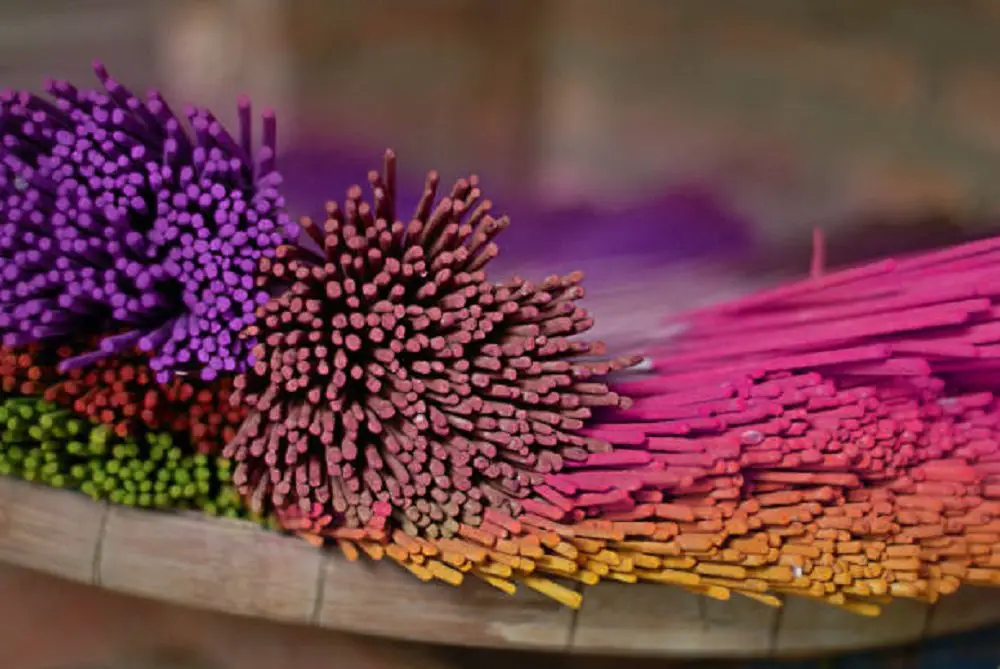Of all the things we learn about keeping house, incense is one of the most overlooked topics. Sure, it smells great, and you can burn it, but it seems that’s all most people know about this ancient and incredible aroma creating substance. How long can you keep incense? How long does it burn? I’ll walk you through some of the basic facts about incense and show you how to preserve it and burn it for much longer. You can keep your home smelling amazing once you understand more about all those sweet-smelling sticks. Moreover, you won’t waste any money because you’ll know how to save it and use it, so you get the most out of your incense sticks.
How long do incense sticks last? Incense sticks can last for years. Over time the fragrant compounds evaporate or lose their potency, but they never officially expire. However, once lit, an incense stick will burn for twenty to ninety minutes on average before it is spent.
How Long Does Incense Last
Preserving your incense so it smells stronger for longer is easy, but how long it will last depends on several factors. For example, what the incense is made from matters a great deal. Low quality, mass-produced incense sticks like those you find in a dollar store is more likely to fall apart. Moreover, it’s often scented with questionable parfum and mystery ingredients.
If you want good incense, I strongly recommend choosing a variety that is hand-rolled or comes from a well known and trusted source. Always read the reviews, and make sure you store your incense correctly. I’ll explain how to do that later in the article.
Does Incense Expire
Incense is not like food. More often than not, it lacks an expiration date. That is because incense isn’t regulated like consumable items you’d ingest. Plus, the industry isn’t subject to near as much oversight, so it’s not a requirement to add a use-by stamp on the packaging.
Unfortunately, that doesn’t mean incense never goes off. Because of improper storage and packaging, most incense loses its aroma over time. Furthermore, once the sticks dry out, they’re prone to crumble, which can leave you with an empty stick and a pile of vaguely fragrant dust.
A two-pack of Satya Sai Baba Nag Champa Agarbatti will keep you burning incense for quite some time. This lovely, classic incense is hand-rolled in India. Thus this incense is the real deal made traditionally. See the Amazon reviews right here.
Keep Your Incense Fresh Longer
Whenever you buy new incense, take it out of the package. Because companies want you to be able to smell the product, the box often has no bag, inside, or a thin plastic bag that may even have a hole punched in it. This is great for finding incense, but not suitable for keeping it fresh.
For basic, short term storage and preservation, transfer your incense sticks into a well-sealed plastic bag. Gallon size freezer bags with the zipper top are excellent. Alternately you can use Tupperware if you have a lot of the same scent.
However, you should never store different incense aromas in the same bag or container. Doing this will cause the scents to blend and become muddled. If you must store incense together, put it in separate bags whenever possible.
If you want to keep incense for the longest time possible, use a Ziploc bag, insert an O2 remover to keep the oils from oxygen. Then, remove as much air as possible and store your incense in dark glass, or otherwise out of direct light. Keep your sticks at or below room temperature.
Incense Burning Science
According to NCBI, “A typical composition of stick incense consists of 21% (by weight) of herbal and wood powder, 35% of fragrance material, 11% of adhesive powder, and 33% of bamboo stick. Incense smoke (fumes) contains particulate matter (PM), gas products, and many organic compounds.”
You will find that since incense is not a food, often, the ingredient list is either absent or incredibly limited. Proprietary blends may list only ‘natural scents, fragrance oil or parfum’ instead of the individual ingredients. As it is not intended to go on or in your body, this makes sense. However, it also makes it hard to tell precisely what you’re burning.
Additionally, the environment where you burn your incense can impact it’s burn time. Higher altitudes have less oxygen, and thus incense and even firewood burn more slowly. Furthermore, the relative humidity can change the burn time of incense. The higher the moisture, the slower the burn.
How Long Incense Burns
The average incense stick lasts twenty to ninety minutes once you light it. So why is there such a big difference in burning time? Primarily the discrepancy has to do with four things.
Firstly, what are the stick and bodies made from? Secondly, what is used for fragrance? Third, how damp or dry is your incense stick when you light it? Finally, how big is your incense stick. Naturally, a longer, thicker or denser stick will burn for longer, but let’s look at the first three factors in greater depth.
Incense sticks are often made from whatever inexpensive wood happens to be available. Commonly bamboo is used, but not always. A unique incense might occasionally have a stick made with a different, denser wood, in which case, the stick itself might burn more slowly. Unfortunately, few companies share their source for the sticks.
Chakras Incense Sticks from Amazon are made from bamboo. Not only do these lovely incense sticks have a long burn time, but even inside the package, they smell amazing. Moreover, you get a free incense burner with this set. Get yours by clicking here.
The main body of the incense stick, the part that holds the smell, typically begins life as a damp paste. Wood dust or sawdust is the most common ingredient. A binding agent like glue or adhesive powder holds it together as it dries.
Again, most companies don’t share their exact recipe so that these components can be incredibly variable. The burn times will depend on how flammable the wood and glue are and their individual burn times. Moreover, the density of the packed material slightly impacts the burn time.
Lastly, the scenting agent makes a difference in a couple of different ways. If your incense is made from fragrant wood dust, like sandalwood, it may not need additional aromatics. However, most incense is mixed with or dipped into essential or fragrance oil.
While oils have different burn times, the variation is slight. However, a damper incense stick will burn more slowly. Since the liquid has to burn off before the underlying sawdust and stick burn, this also causes more smoke.
Why Does Your Incense Burn So Fast
Perhaps you, like many people, light an incense stick, and it burns out very quickly, hardly seeming to last at all. Why is it gone so fast? The secret lies in the angle at which you burn your incense.
When you place your incense sticks horizontally, they will burn faster than a verticle stick. This effect is due to the contact surface of the burning area. Incense burners typically hold your sticks at a forty-five-degree angle to get the right balance between fast and slow-burning.
If you find you have trouble keeping your incense lit, choose a drier incense, and decrease the angle to near flat. Alternately, super-fast burning incense might need a ninety-degree angle, so it sticks straight up. Otherwise, opt for more substantial or more moist incense to increase your burn time.
Dry & Damp
Intriguingly, because the humidity matters as well, people who live in the swamp, jungle, or wet climates will get a longer burn time than a desert dweller. If your air is mainly dry, you may want to consider keeping incense in a cigar humidor.
Controlling the relative humidity of your incense will give you a longer burn. However, do not moisten incense. Too much water from a humidifier or spray bottle can cause the adhesive to let go. Resultantly, you get a damp pile of sawdust. Worse, it could cause partially burning incense to fall from the stick creating a fire hazard.
Always make sure to burn incense in a holder. You should place your incense holder away from any moving air, like fans and vents. Doing this will prevent still-burning ash from spreading around your home. Moreover, make sure the surface you set your incense on is reasonably fire-proof.
Do Cones or Sticks Burn Longer
Because of the shape and size, incense cones do not burn for very long. Although the base is often wider than an incense stick, it is burning over that larger area as well. For this reason, incense cones will almost always burn faster than sticks.
The only exception to this rule would be a very small, or extremely dry incense stick. Even then, it would need to be nearly horizontal.
A Variety Pack of Karma Scents Premium Incense will keep your home smelling lovely and harmonious. These hand-rolled and hand-blended sticks come from India. You’ll be surprised at the beautiful packaging and variety of the scents offered. Find out more on Amazon by clicking here.
Final Thoughts
Incense can keep your home smelling delightful long after it has burnt out, and unburnt incense can last for months or years before the aroma is faded. Once you light a stick, it will only burn for around a half-hour to an hour on average. Yet the scent can linger much longer.
Incense has been around for thousands of years. It was burnt in India and China as early as thirty-three hundred b.c. The aroma of burning herbs and oils is deeply ingrained into the human experience.
Make your incense last longer by choosing high-quality products and storing them correctly. Then simply make sure you set it up correctly for longer burn times.

